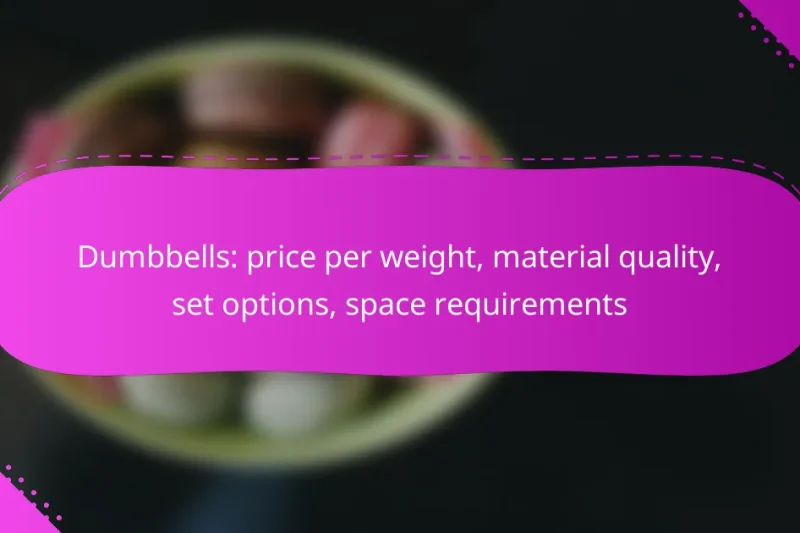A quality yoga mat is essential for enhancing comfort and stability during practice, ensuring a safe … Yoga Mat: comfort during practice, stability, injury prevention, portabilityRead more
Cost Considerations for Home Fitness Equipment
Investing in home fitness equipment can be a significant financial commitment, with prices in Australia ranging from a few hundred to several thousand dollars depending on the type and brand. To make informed decisions, it’s essential to assess your budget and fitness goals, ensuring you prioritize the equipment that best suits your needs. Additionally, various financing options are available, allowing you to manage costs and make your fitness journey more accessible.
Balance Board: cost factors, material quality, brand reputation, usage
When considering a balance board, several cost factors come into play, including material quality, brand reputation, … Balance Board: cost factors, material quality, brand reputation, usageRead more
Dumbbells: price per weight, material quality, set options, space requirements
Dumbbells are a versatile addition to any fitness routine, with prices in Australia generally ranging from … Dumbbells: price per weight, material quality, set options, space requirementsRead more
Foam Roller: price range, material quality, durability, usage frequency
Foam rollers are available in a price range of approximately AUD 10 to over AUD 100, … Foam Roller: price range, material quality, durability, usage frequencyRead more
Kettlebells: cost per weight, material type, set options, durability
Kettlebells are a versatile fitness tool, with costs varying between AUD 2 to AUD 5 per … Kettlebells: cost per weight, material type, set options, durabilityRead more
Jump Rope: price range, material quality, durability, brand reputation
Jump ropes in Australia are available at a wide price range, typically from under AUD 20 … Jump Rope: price range, material quality, durability, brand reputationRead more
Power Rack: initial cost, safety features, space requirements, brand reputation
A power rack is a versatile piece of gym equipment that can range in initial cost … Power Rack: initial cost, safety features, space requirements, brand reputationRead more
Resistance Bands: price range, quality differences, set options, usage frequency
Resistance bands are a versatile and cost-effective tool for enhancing your fitness routine, with prices in … Resistance Bands: price range, quality differences, set options, usage frequencyRead more
Barbell: strength training, muscle mass increase, versatility, stability
Barbells are a versatile and powerful tool for strength training, enabling individuals to effectively increase muscle … Barbell: strength training, muscle mass increase, versatility, stabilityRead more
Treadmill: initial cost, maintenance expenses, warranty options, resale value
Investing in a treadmill involves considering the initial cost, which can range from a few hundred … Treadmill: initial cost, maintenance expenses, warranty options, resale valueRead more
What are the costs of home fitness equipment in Australia?
The costs of home fitness equipment in Australia can vary significantly based on the type, brand, and features. Generally, you can expect to spend anywhere from a few hundred to several thousand Australian dollars, depending on your fitness goals and equipment preferences.
Average price range for popular brands
Popular fitness equipment brands in Australia typically offer products within a range of prices. For example, basic cardio machines like treadmills and stationary bikes can start around AUD 500, while more advanced models may cost between AUD 1,500 and AUD 3,000. Strength training equipment, such as dumbbells and weight benches, usually falls between AUD 100 and AUD 1,000.
Brands like NordicTrack, ProForm, and Bowflex are well-known and often provide a variety of options to suit different budgets. It’s advisable to compare prices across retailers to find the best deals.
Factors affecting equipment pricing
<pSeveral factors influence the pricing of home fitness equipment in Australia. The brand reputation plays a significant role, as established brands often charge more for their products due to perceived quality and reliability. Additionally, the type of equipment—whether it's cardio, strength, or multifunctional—can affect the price, with multifunctional machines generally being more expensive.
Other considerations include the materials used, warranty offerings, and included features such as digital displays or connectivity options. Higher-end models with advanced technology tend to command higher prices.
Comparison of budget vs premium options
When comparing budget and premium home fitness equipment, it’s essential to weigh the pros and cons. Budget options may be more affordable, typically ranging from AUD 100 to AUD 800, but they might lack durability and advanced features. They are suitable for beginners or those with limited space.
In contrast, premium options, often priced from AUD 1,000 upwards, usually offer better build quality, longer warranties, and advanced functionalities. Investing in premium equipment can be worthwhile for serious fitness enthusiasts who plan to use the equipment regularly.
How to budget for home fitness equipment?
To budget for home fitness equipment, start by determining your overall financial limits and specific fitness goals. This will help you allocate funds effectively while ensuring you prioritize what you truly need for your home workout routine.
Creating a fitness equipment budget
Begin by assessing your current financial situation and setting a realistic budget for fitness equipment. Consider factors such as monthly income, expenses, and any savings goals. A common approach is to allocate around 5-10% of your monthly income towards fitness-related purchases.
Next, list the equipment you are interested in and research their prices. Create a spreadsheet to track costs, including potential shipping fees or taxes. This will help you visualize your budget and make informed decisions.
Prioritizing essential vs optional equipment
Identify essential equipment that aligns with your fitness goals, such as a quality pair of running shoes, a yoga mat, or resistance bands. These items typically offer the most value and versatility for home workouts. Aim to spend the majority of your budget on these essentials.
Optional equipment, like specialized machines or luxury items, can enhance your workout experience but may not be necessary. Consider waiting to purchase these until you have established a consistent routine and can assess their true value to your fitness journey. A good rule of thumb is to spend no more than 20-30% of your budget on optional items.
What financing options are available for fitness equipment?
Several financing options exist for purchasing fitness equipment, allowing buyers to manage costs more effectively. These include installment payment plans and credit options from retailers, each with unique features and considerations.
Installment payment plans
Installment payment plans allow customers to spread the cost of fitness equipment over several months. Typically, these plans require a down payment followed by monthly payments, which can range from a few months to several years, depending on the total cost and terms agreed upon.
When considering installment plans, look for interest rates and any associated fees. Some retailers offer interest-free periods, which can be beneficial if you can pay off the balance within that time frame. Always read the fine print to avoid unexpected charges.
Credit options from retailers
Many retailers provide credit options specifically for fitness equipment purchases, often through partnerships with financial institutions. These credit lines can offer promotional rates, such as zero-interest financing for a limited time, making them an attractive choice for buyers.
Be cautious with credit options, as they may come with high-interest rates after the promotional period ends. It’s essential to evaluate your ability to repay the borrowed amount within the promotional timeframe to avoid accumulating debt. Additionally, check for any penalties for late payments, as these can significantly increase your overall cost.
What are the shipping and return costs for fitness equipment?
Shipping and return costs for fitness equipment can vary significantly based on the retailer, the size of the item, and the delivery location. Understanding these costs is crucial for budgeting your home fitness setup.
Shipping fees for major Australian retailers
Shipping fees for fitness equipment in Australia typically range from AUD 10 to AUD 100, depending on the retailer and the weight of the item. Some retailers offer free shipping on orders over a certain amount, often around AUD 200. It’s advisable to check each retailer’s shipping policy before purchasing.
For example, larger retailers like Rebel Sport and Gym Direct may have different shipping rates based on the type of equipment, such as treadmills versus weights. Always look for promotional offers or discounts that can help reduce shipping costs.
Return policies and associated costs
Return policies for fitness equipment can vary widely, with many retailers offering a 30-day return window. However, some may charge restocking fees, typically around 10-20% of the purchase price, especially for larger items. Always read the return policy carefully before buying.
In Australia, if the equipment is faulty or not as described, you are entitled to a full refund under consumer law. For non-faulty returns, you may need to cover the return shipping costs, which can add to your overall expenses. Consider keeping the original packaging to facilitate easier returns.
How to assess the value of fitness equipment?
Assessing the value of fitness equipment involves evaluating its quality, functionality, and long-term benefits relative to its cost. Key factors include durability, warranty, and potential resale value, which can significantly influence your investment decision.
Evaluating durability and warranty
Durability is crucial when selecting fitness equipment, as it affects how long the equipment will last and how well it performs over time. Look for materials that are known for their strength, such as steel frames and high-quality plastics, as well as user reviews that highlight longevity.
A strong warranty can provide peace of mind and protect your investment. Many reputable brands offer warranties ranging from one to several years, covering parts and labor. Always check the warranty details to understand what is included and any conditions that may apply.
Understanding resale value
Resale value is an important consideration if you plan to upgrade or change your fitness equipment in the future. Equipment from well-known brands typically retains higher resale value, while niche or lesser-known brands may depreciate more quickly.
To maximize resale value, keep the equipment in good condition and maintain all original packaging and documentation. Research similar items on resale platforms to gauge market demand and set a competitive price when you decide to sell.
What are the long-term costs of owning fitness equipment?
The long-term costs of owning fitness equipment extend beyond the initial purchase price and can significantly impact your budget. Key factors include maintenance, repair, and the ongoing costs associated with space and utilities.
Maintenance and repair expenses
Regular maintenance is essential to keep fitness equipment in good working condition. Depending on the type of equipment, maintenance costs can range from minimal for basic machines to several hundred dollars annually for advanced or specialized gear.
Common repairs may include replacing worn-out parts, lubricating moving components, or recalibrating machines. Setting aside about 5-10% of the equipment’s purchase price each year for maintenance can help manage these costs effectively.
Space considerations and utility costs
Owning fitness equipment requires adequate space, which may lead to additional costs if you need to modify your home. Consider the potential expenses of renovating a room or renting extra space to accommodate larger machines.
Utility costs can also increase, especially for equipment that requires electricity, such as treadmills or stationary bikes. Monthly electricity bills may rise by a few dollars, depending on usage, so factor this into your overall budget for home fitness.









